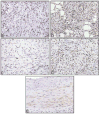Hormone receptor expression in renal angiomyolipoma: clinicopathologic correlation
- PMID: 18374399
- PMCID: PMC2789392
- DOI: 10.1016/j.urology.2008.01.067
Hormone receptor expression in renal angiomyolipoma: clinicopathologic correlation
Abstract
Objectives: Although renal angiomyolipoma (AML) occurs more commonly in females than males, the origin of this difference in incidence by sex is unknown. Therefore, we investigated the expression of the androgen receptor (AR), estrogen receptor subtypes alpha (ERalpha) and beta (ERbeta), progesterone receptor, and the enzyme aromatase in renal AML.
Methods: We evaluated specimens from 110 patients who had undergone resection of a renal AML, including 90 women and 20 men. Immunohistochemistry was performed using monoclonal antibodies on paraffin-embedded tissue sections. Expression was correlated with patient demographics and tumor pathologic features.
Results: ERbeta was expressed in 100% (106 of 106) of the AML specimens evaluated. Of the 104 specimens that could be assessed for the AR, 82 (79%) demonstrated staining. Of 110 lesions, 31 (28%), 42 (38%), and 11 (10%) expressed ERalpha, progesterone receptor, and aromatase, respectively. The level of ERbeta expression was not associated with patient age (P = 0.92), sex (P = 0.82), a diagnosis of tuberous sclerosis (P = 0.56), or histologic subtype of AML (P = 0.94). A trend was found toward increased AR expression in men (P = 0.069) and younger patients (P = 0.052), and ERalpha was expressed in the AML specimens from 5 (71%) of 7 patients with tuberous sclerosis compared with 26 (25%) of 103 without tuberous sclerosis (P = 0.018). Both AR and ERalpha expression were more common in the triphasic subtype of AML than in the lipomatous tumors (P = 0.046 for both).
Conclusions: The results of our study have shown that ERbeta expression is ubiquitous in renal AML, and the AR is found in most tumors. ERalpha and progesterone receptor were expressed in approximately one third of cases. These data suggest a potential role for hormones in the pathogenesis and management of renal AML.
Figures

References
-
- Lemaitre L, Robert Y, Dubrulle F, et al. Renal angiomyolipoma: growth followed up with CT and/or US. Radiology. 1995;197:598–602. - PubMed
-
- Nelson CP, Sanda MG. Contemporary diagnosis and management of renal angiomyolipoma. J Urol. 2002;168:1315–1325. - PubMed
-
- Hajdu SI, Foote FW., Jr Angiomyolipoma of the kidney: report of 27 cases and review of the literature. J Urol. 1969;102:396–401. - PubMed
-
- Van Slegtenhorst M, de Hoogt R, Hermans C, et al. Identification of the tuberous sclerosis gene TSC1 on chromosome 9q34. Science. 1997;277:805–808. - PubMed
-
- Identification and characterization of the tuberous sclerosis gene on chromosome 16. Cell; The European Chromosome 16 Tuberous Sclerosis Consortium; 1993. pp. 1305–1315. - PubMed
MeSH terms
Substances
Grants and funding
LinkOut - more resources
Full Text Sources
Medical
Research Materials

